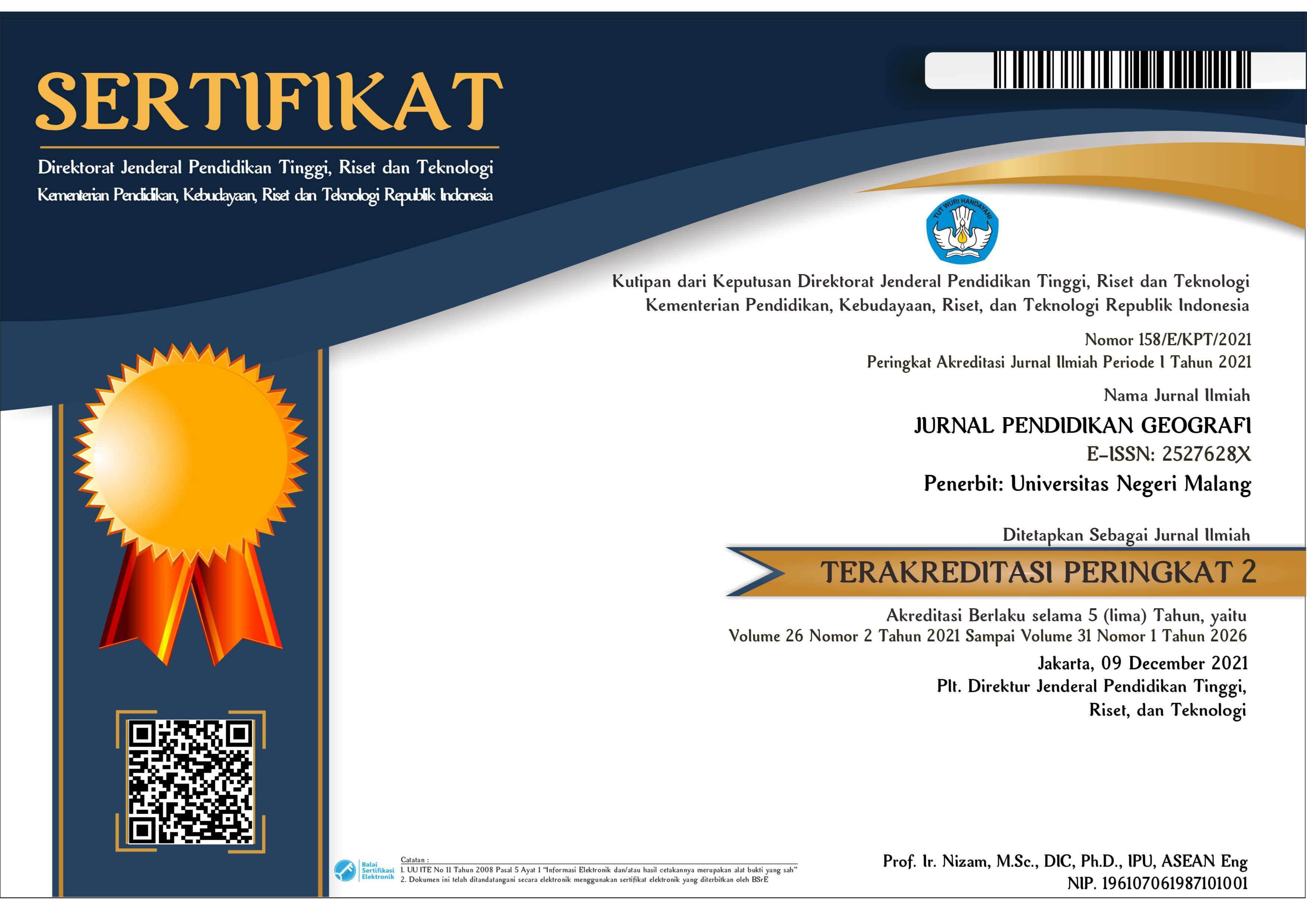Influencing factors for the human development index in West Java using geographically and temporally weighted regression kernel functions
Abstract
Human Development Index (HDI) is a competitive index that serves as one of the crucial metrics for evaluating the effectiveness of enhancing the quality of human resources. HDI values from different areas can be compared. This study aims to spatially and temporally explore the HDI data from districts or cities in West Java and examine the factors that influence HDI in each of these districts or cities using the GTWR Great Circle Distance Fixed Kernels model. In this study, we used a combination of cross-sectional data from districts or cities in West Java and time series data with seven annual periods from 2015-2021. The GTWR Great Circle Distance Fixed Kernels model was expected to display coefficient values at each location and time simultaneously, providing more in-depth information and analysis results at each location and time. The analysis results using the GTWR Great Circle Distance Fixed Kernels model show that HDI in West Java carries a positive influence on the location and time. This finding should be of particular concern to the relevant government, particularly the factors presenting a natural effect on HDI based on location and time. The positive influence obtained by an area at a particular time will also have a positive impact on other regions, and if there is a negative influence, it will undoubtedly affect other regions as well. Analysis of the HDI model in West Java using the GTWR Great Circle Distance Fixed Exponential Kernel model also presents better results in comparison to the Global OLS model and the GTWR model without the Great Circle Fixed Exponential Kernel. The final parameter estimator results are displayed in the form of a geographic map to facilitate ease of understanding.
Keywords
Full Text:
PDFReferences
Aghayari, M., Pahlavani, P., & Bigdeli, B. (2017). A geographic weighted regression for rural highways crashes modelling using the Gaussian and Tricube kernels: A case study of USA rural highways. International Archives of the Photogrammetry, Remote Sensing and Spatial Information Sciences, 42(4/W4), 305–309.
Aidi, M. N., Ernawati, F., Efriwati, E., Nurjanah, N., Rachmawati, R., Julianti, E. D., … Nurfadilah, K. (2022). Spatial distribution and identifying biochemical factors affecting haemoglobin levels among women of reproductive age for each province in Indonesia: A geospatial analysis. Geospatial Health, 17(2), 1118.
Bhanojirao, V. V. (1991). Human development report 1990: Review and assessment. World Development, 19(10), 1451–1460.
Chu, H.-J., Kong, S.-J., & Chang, C.-H. (2018). Spatio-temporal water quality mapping from satellite images using geographically and temporally weighted regression. International Journal of Applied Earth Observation and Geoinformation, 65, 1–11.
Conita, C., & Purwaningsih, T. (2020). Under-five mortality rate modeling using Geographically and Temporal Weighted Regression (GTWR). Ahmad Dahlan International Conference on Mathematics and Mathematics Education, 1(1), 59–67.
Du, Z., Wu, S., Zhang, F., Liu, R., & Zhou, Y. (2018). Extending geographically and temporally weighted regression to account for both spatiotemporal heterogeneity and seasonal variations in coastal seas. Ecological Informatics, 43, 185–199.
Feng, Z., Xu, C., Zuo, Y., Luo, X., Wang, L., Chen, H., … Liang, T. (2023). Analysis of water quality indexes and their relationships with vegetation using self-organizing map and geographically and temporally weighted regression. Environmental Research, 216, 114587.
Fotheringham, A. S., Brunsdon, C., & Charlton, M. (2003). Geographically weighted regression: The analysis of spatially varying relationships. John Wiley & Sons.
Fotheringham, A. S., Crespo, R., & Yao, J. (2015). Geographical and Temporal Weighted Regression (GTWR). Geographical Analysis, 47(4), 431–452.
Fu, Z., & Li, R. (2020). The contributions of socioeconomic indicators to global PM2. 5 based on the hybrid method of spatial econometric model and geographical and temporal weighted regression. Science of the Total Environment, 703, 135481.
Harahap, R. N. (2022). Implementasi Geographically Weighted Regression (GWR) dan Mixed Geographically Weighted Regresion (MGWR) dalam perhitungan jumlah penduduk miskin (studi kasus: Jumlah penduduk miskin Provinsi Jawa Tengah 2020). Universitas Islam Indonesia.
Haryanto, S., Aidi, M. N., & Djuraidah, A. (2019). Modelling of GRDP the construction sector in Java Island using Robust Geographically and Temporally Weighted Regression (RGTWR). Repositories-Dept. of Statistics, IPB University, 6, 165–174.
Hickel, J. (2020). The sustainable development index: Measuring the ecological efficiency of human development in the anthropocene. Ecological Economics, 167, 106331.
Huang, B., Wu, B., & Barry, M. (2010). Geographically and temporally weighted regression for modeling spatio-temporal variation in house prices. International Journal of Geographical Information Science, 24(3), 383–401.
Ilhami, S., Nuryartono, N., & Achsani, N. A. (2014). Analisis pengaruh anggaran pendidikan terhadap indeks pembangunan manusia di Indonesia. Sekolah Pascasarjana Instutut Pertanian Bogor.
Li, W., Ji, Z., & Dong, F. (2022). Spatio-temporal evolution relationships between provincial CO2 emissions and driving factors using geographically and temporally weighted regression model. Sustainable Cities and Society, 81, 103836.
Ling, L., Qian, X., Guo, S., & Ukkusuri, S. V. (2022). Spatiotemporal impacts of human activities and socio-demographics during the COVID-19 outbreak in the US. BMC Public Health, 22(1), 1466.
Liu, J., Zhao, Y., Yang, Y., Xu, S., Zhang, F., Zhang, X., … Qiu, A. (2017). A mixed geographically and temporally weighted regression: Exploring spatial-temporal variations from global and local perspectives. Entropy, 19(2), 53.
Lukiswati, I. (2019). Regresi panel terboboti geografis pada indeks pembangunan gender Jawa Tengah Tahun 2011-2015. Institut Pertanian Bogor.
Ma, X., Zhang, J., Ding, C., & Wang, Y. (2018). A geographically and temporally weighted regression model to explore the spatiotemporal influence of built environment on transit ridership. Computers, Environment and Urban Systems, 70, 113–124.
Malau, D. B. (2022). Analisis dampak desentralisasi fiskal terhadap IPM(IPM) dan kemiskinan di Provinsi Sumatera Selatan. Institut Pertanian Bogor.
Meyer, S., Held, L., & Höhle, M. (2014). Spatio-temporal analysis of epidemic phenomena using the R package surveillance. ArXiv Preprint ArXiv:1411.0416.
Pamungkas, R. A., Yasin, H., & Rahmawati, R. (2016). Perbandingan model GWR dengan fixed dan adaptive bandwidth untuk persentase penduduk miskin di Jawa Tengah. Jurnal Gaussian, 5(3), 535–544.
Porcu, E., Bevilacqua, M., & Genton, M. G. (2016). Spatio-temporal covariance and cross-covariance functions of the great circle distance on a sphere. Journal of the American Statistical Association, 111(514), 888–898.
Shim, J., & Hwang, C. (2018). Kernel-based geographically and temporally weighted autoregressive model for house price estimation. PloS One, 13(10), e0205063.
Sholihin, M., Soleh, A. M., & Djuraidah, A. (2017). Geographically and temporally weighted regression (GTWR) for modeling economic growth using R. Repositories-Dept. of Statistics, IPB University, 800–805.
Wei, Q., Zhang, L., Duan, W., & Zhen, Z. (2019). Global and geographically and temporally weighted regression models for modeling PM2. 5 in Heilongjiang, China from 2015 to 2018. International Journal of Environmental Research and Public Health, 16(24), 5107.
Xu, X., Luo, X., Ma, C., & Xiao, D. (2020). Spatial-temporal analysis of pedestrian injury severity with geographically and temporally weighted regression model in Hong Kong. Transportation Research Part F: Traffic Psychology and Behaviour, 69, 286–300.
Yasin, H., Sugito, S., & Prahutama, A. (2015). Analisis data kemiskinan di Jawa Tengah menggunakan Metode Mixed Geographically and Temporally Weighted Regressions (MGTWR). BIAStatistics, 9(1), 15–23.
DOI: http://dx.doi.org/10.17977/um017v28i22023p228-241
Refbacks
- There are currently no refbacks.
Copyright (c) 2023 Jurnal Pendidikan Geografi: Kajian, Teori, dan Praktek dalam Bidang Pendidikan dan Ilmu Geografi

This work is licensed under a Creative Commons Attribution-ShareAlike 4.0 International License.
Jurnal Pendidikan Geografi: Kajian, Teori, dan Praktek dalam Bidang Pendidikan dan Ilmu Geografi is licensed under Creative Commons Attribution-ShareAlike 4.0 International License,
JPG Indexed By:
View My Stats








12.png)
